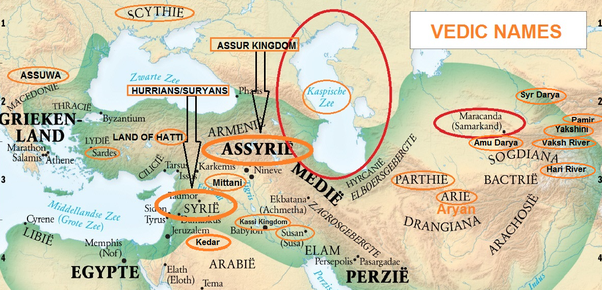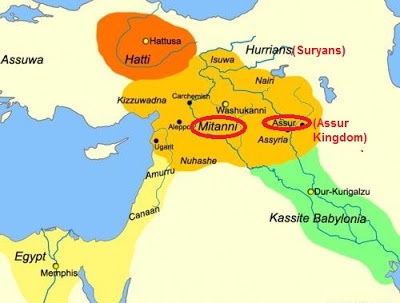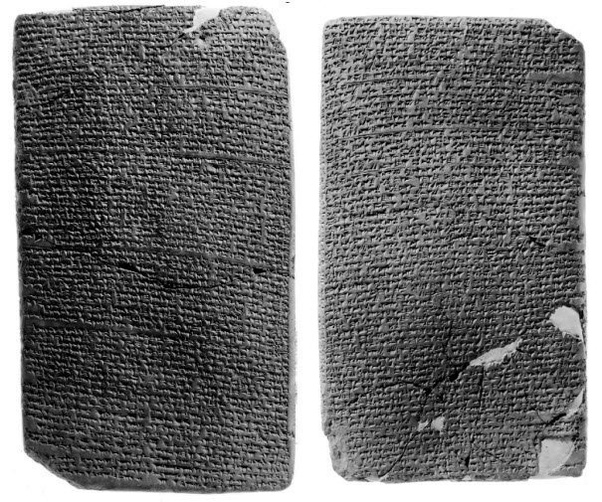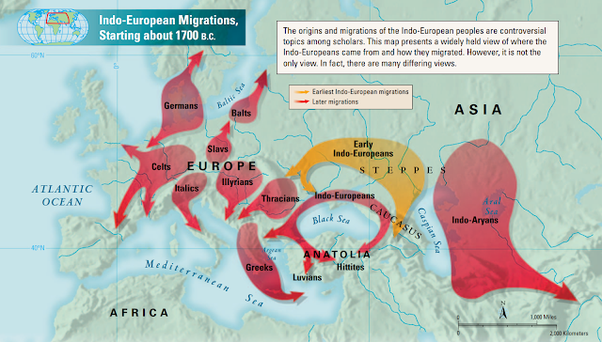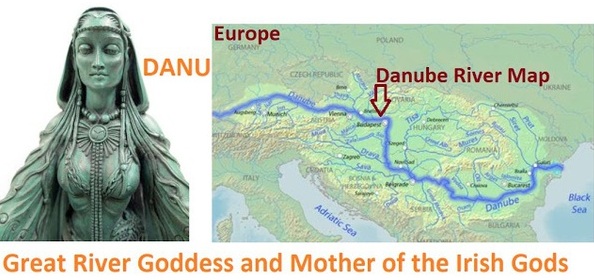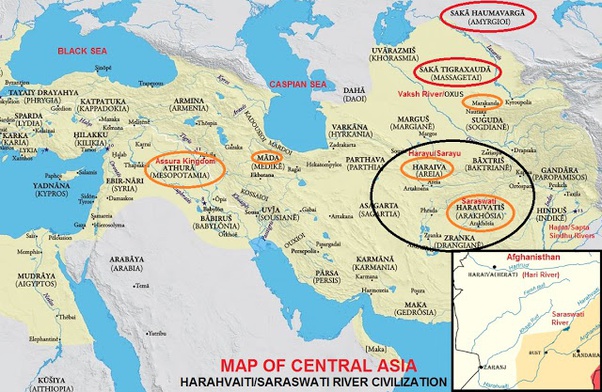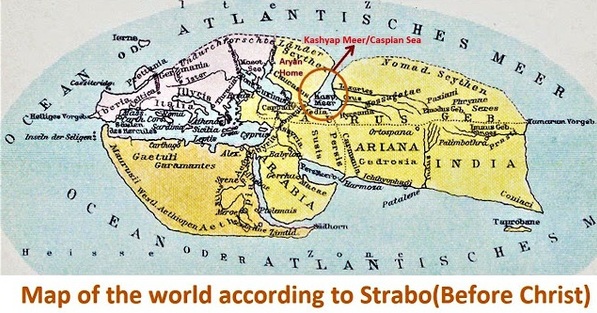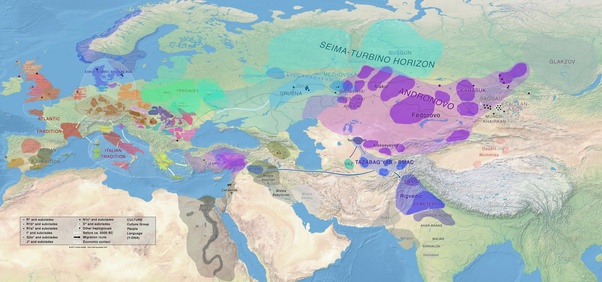
| WHO WERE ASURS
In Hindu mythology, Asurs / Asuras are described as powerful superhuman demigods or demons with good or bad qualities. The good Asuras are called Adityas and are led by Varun, while the malevolent ones are called Danavs and are led by Vritra. In the earliest layer of Vedic texts Agni, Indra and other gods are also called Asuras, in the sense of them being "lords" of their respective domains, knowledge and abilities. In later Vedic and post-Vedic texts, the benevolent gods are called Devs, while malevolent Asuras compete against these Devas and are considered "enemy of the gods" or demons.
Looking at below map of central Asia, the Sura and Asura Split - could be the basis for countries being named Syria and Assyria. Several sources indicate that the name Syria is derived from the 8th century BC Luwian term "Sura/i", and the derivative ancient Greek name: Sýrioi, or Sýroi, both of which originally derived from Aššurayu (Assyria) in northern Mesopotamia. Mainstream modern academic opinion strongly favors the argument that the Greek word is related to the cognate Assyria, ultimately derived from the Akkadian Aššur.
Asko Parpola traces the etymological root of Asura to asera- of Uralic languages, where it means "lord, prince". In similar reference, "Assur" was the father of the Assyrians and was regarded as "the great god, king of all the gods." It was Asshur who gave power and life to every priestly king.
Just as an example, take current Iraq's capital Baghdad as example. All scholars agree that it had earlier Assyrian origin and was referred as Baghdadu by Assyrian or Assur kings. In Hindu mythology, Narak'asur' is a legendary asur who also had son named Baghdadu. Bagh refers "GOD" and dad "given", translating to "God-given" and both of these civilization refer this town with same meaning from ancient days till today. Bhagvat Puran is "God given epic" in our Hindu Mythology. Again, we refer GOD as 'Bhag' for Bhagvan Buddha, Bhagvan Ram, Bhagvan Krishna etc. A devotee of Bhagvan Krishna is called a Bhagvat.
Further, it is very clear that the names of the kings of the Mitanni state were of Indo-Aryan origin and a number of Indo-Aryan gods (Mitra, Varun, Indra, Nasatya) are mentioned in the Mitanni texts, alongside the indigenous gods.
The Hittite archives of Àattušašhave revealed the oldest known horse-training manual Several Indo-Aryan technical terms for horse training are mentioned in this manual: aikawartanna ‘one turn (of the course)’ (Sanskrit eka-vartana-), terawartanna ‘three turns’, panzawartanna ‘five turns’ (Sanskrit pañca-),sattawartanna ‘seven turns’ (Sanskrit sapta-), and nawartanna (for nawa-wartanna) ‘nine turns’ (Sanskrit nava). The first time historically the word Ratha is used as chariot is around 1650BCE with the Hurrians of the Middle East. These Hurrian's had hundreds of Vedic Sanskrit loan words. (Assuwa) is name of an Anatolian landscape in Hittite and Assyrian sources of the 15th century BCE.
In European side (Western side of Caspian Sea / Kashyap sea), we can clearly reflect ancient vedic tribes of Danu from Sage Kashyap
As per Hindu Purans, Danu is wife of Sage Kashyap and she is Hindu primordial goddess and is mentioned in the Rigved as mother of Danavs tribe. As a word for "rain" or "liquid", Danu is compared to Avestan danu, "river", and further to river names like Don, Danube, Dneiper, Dniestr, etc. derive from Goddess Danu. The name 'Danube' is said to derive from Proto-Indo-European. In Celtic Mythology, the Goddess Danu was the mother Goddess of the Tuatha Dé Danann (The Tribes of Danu). Greeks were also called Danuni.
References
:
Ancient European Gods like Zeus, Jupiter have similar mythological stories like that of Dyaus, Indra (God of heaven) of Hindu mythology.
Reference :
Jupiter / Zeus-Pitar / Dyaus-Pitar - (Sanskrit Origin) - Dyaus
Further, there are striking similarities between the Eastern Iranian language of Avestan and Sanskrit, which may support the notion that the split was contemporary with the Vedic civilization living in Afghanistan at a very early stage. It is believed that King Vishtaspa was early follower of Zoroastrianism and and instrumental in the diffusion of the prophet's message - Zarathustra.
Ahura Mazda and Asura Medhira :
Below data from Rig Ved 1.35.10 describes Asur as kind leader.
May
he, gold-handed Asurah, kind Leader, come hither to us with his
help and favour.
Rig Ved Mandala 1, Sukt 35, Mantra (Hymn) 10
Ahura Mazda, whom the Zoroastrians worship as the Supreme Lord is the Avestan equivalent to Vedic Sanskrit's Asura Medhira. These phrase means "Wise Lord", and in the Rigved it appears in a few places. In RV XXIV.14 "ksayannasmabhyamasura" appears in the sentence, "With bending down, oblations, sacrifices, O Varu?a, we deprecate thine anger: / Wise Asura, thou King of wide dominion, loosen the bonds of sins by us committed." There are several passages in the Vedas, especially the Atharvaveda and Avesta that are identical, except that they are in the different languages of Avestan and Vedic Sanskrit.
Ceremonies using a sace or ses which is a tray that holds various ceremonial utensils is almost similar to rituals done by Brahmin priests in Hindu community.
Sace / Ses. Zoroastrian Ceremonial Tray
Even Thread ceremony of Brahmins is similar to Navjot of Zoroastrianism.
Navjote, Sudreh Pooshi, Zoroastrian Initiation Ceremony
Inside house Brahmin ceremonies like Havana, Hoama is almost similar like rituals of Zoroastrianism :
Zoroastrian Liturgical Ceremonies (Zoroastrianism)
Rig Vedic Som Yajna Ceremony is almost similar to Haom (Hom) of Zoroastrians. Haoma is Persian word.
Haom
/ Hom / Homa
Map of Central Asia Most important of all rivers in Central Asia are Oxus and Jaxartes that run parallel. Ancient Persian/Avestan texts refer these rivers as Yakhsha and Vakhsha. Oxus is corrupted from Sanskrit word for Vaks ( Vaksh River). The Greek name for river Jax-artes or Iax-artes is derived from Old Persian name "Yakhsha Arta".
Details about Oxus and History :
Vakhsh in its eastern parts (Vak means Speech in Sanksrit)
Many agree that early Vedic civilization being centered around Oxus / Vakhsh (Vaku) rivers. These rivers signifies sharp / sight and speech. There is a relationship with Iksh-vaku (Sharp sight-speech), the well-known sage. Iksh-vaku is the great grandson of Sage Kashyap. Lord Ram, Lord Buddh and great Suryavanshi kings belong to Ikshvaku dynasty.
These rivers (Yakhsh and Vakhsh) flows for a length of 2400 km across modern Tajikistan, Afghanistan, Turkmenistan and Uzbekistan into Lake Aral. There are evidences that earlier, it used to meet Caspian sea (Kaspische Zee) and the river course got changed possibly due to earth quakes. In ancient maps of Strabo, we can clearly see that Caspian Sea was known as 'Kasyap Meer' or 'Kaspische Zee / Sea' named after Rishi Kashyap - the father of the devtas, asurs, nags and all of humanity as per Hindu Mythology.
Additional fact to support migration theory is, both of these early dynasty rulers (Hurrian-speaking Mitanni people) which moved towards west and people related to Ikshvaku dynasty moved from Hindu-kush eastwards pray same Vedic GOD ( Indra, Varun, Mitra, Agni etc). The Hurrian-speaking Mitanni people and the king of Mitanni refer series of Hurrian gods like Mitrašil, Uruvanaššil, Indara, and Našatianna, who correspond to the Vedic gods Mitra, Varun, Indra, and Nasatya (Asvin) in peace treaty with Egyptian kings as displayed in Clay tablets of those days.
Tushratta : Tushratta / Dashratta (Sanskrit Tvesa-ratha, "his chariot charges") was a king of Mitanni. Below is peace treaty letter to Egyptian king.
It is to be noted that the first wave consisted of the Indo-Aryan migration into Syria, founding the Mittani kingdom, and a migration south-eastward of the Vedic people, over the Hindu Kush into northern India.The Indo-Aryans split-off around 1800–1600 BCE due to internal conflicts. One group were the Indo-Aryans who founded the Mitanni kingdom in northern Syria;(c. 1500–1300 BCE) the other group were the Vedic tribes who entered Indian sub-continent.
Genetic and Cultural Reconstruction of the Migration of an Ancient Lineage |
|||||||||||||||||||||||||||||||||||||||||||||||
